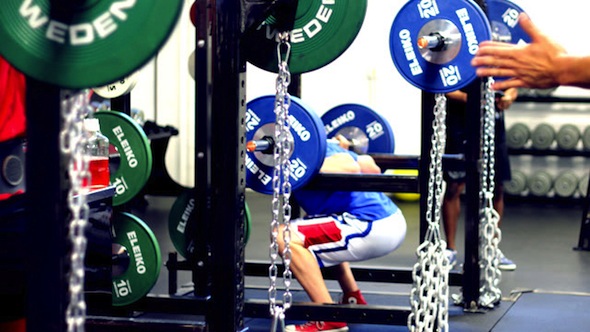Not only is squatting with chains one of the coolest things you can do in the gym, but it can be one of the most effective as well.
I was originally turned onto the concept by powerlifting legend Louie Simmons. Louie was using chain squats to improve the lifting speed of his powerlifters, and as a result, bringing up their squat poundages in the process.
Many of you reading this, though, aren’t powerlifters.
And as such, your goal probably doesn’t involve cramming yourself into a squat suit, hitting an ammonia cap, and then pulverizing a maximal squat attempt.
Regardless, there are numerous reasons you can and should use chains in your programming.
Here are just four reasons I feel anyone and everyone can benefit from squatting with chains.
1 – Improving Bar Speed
Just like Louie originally intended, one of the primary reasons to squat with chains is to improve your bar speed when squatting.
When set-up appropriately, as you set-up to squat all of the chains should be off the ground. As you lower down into the hole, the chains will pile up on the ground, effectively removing their weight from the bar (for the time being).
As you stand up, the weight of the chains is re-applied to the bar, so you better focus on getting up fast to “outrun” the chains.
Not only is this brutally effective for powerlifters who train and compete in powerlifting gear, but it also mimics the strength curves we all know and inherently understand.
When squatting, the easiest portion of the lift is the top – which is why every bro in the gym does quarter squats versus going below parallel or butt-to-calves.
To offset this, training with chains (or bands) plays on a concept called accommodating resistance. Quite simply, it unloads the weight in the weakest portion of the lift (the bottom), and adds more resistance where your leverages improve (the top).
For more information on accommodating resistance, you absolutely must read this article:
This type of training is most beneficial if you are a slower lifter, or one that has a slow and steady bar speed when lifting.
If we want to reference the speed-strength continuum, the lifters who are most suited to benefit from this type of training are the ones that have that low-end torque like a Mac truck, but not the high-end top speed of a Ferrari.
While you can obviously improve your squatting speed, I think this carries over to sports performance as well. Rather than continuously chasing higher and higher levels of absolute or maximal strength, I think there’s a time and place where we should shift the emphasis to maintaining max strength, while shifting the emphasis more so to power development.
While speed training is the most obvious benefit of squatting with chains, here are a few more that I don’t hear discussed nearly as often.
2 – Improved Core and Trunk Stability
If you’ve ever squatted with chains, you know one of the most challenging issues is simply getting yourself set with the bar.
From the second you unrack the weight and walk it out, you realize this is a lot different from squatting with plates. The chains are whipping you all over the place, and in my opinion, this is an uber-effective way to train the core and trunk.
Furthermore, while squatting with chains is a great option, I remember physical therapist Mike Hope talking about how he used barbell lunges with chains to provide an “unstable” training effect in his programs.
Not only do you get all the benefits of the split-squat, but you place a greatly increased demand on core and trunk stability as well.
When you consider the fact that most people DO NOT need to be training with their foot in an unstable environment (think Bosu balls, Dyna discs, etc.), this is a great way to get that unstable training effect, without sacrificing our biomechanics in the process.
BTW – if you want or need to learn more about unstable surface training, be sure to check out Eric’s manual on the topic.
3 – Improve Squat Technique
One of the issues I, personally, have had when squatting in the past is getting dumped forward. This was due to several issues:
- an extremely low bar position,
- a short torso and long femurs, and
- a technical flaw where I wanted to lean forward.
Cleaning up my bar position has made a big difference – by moving it up on my back I am able to stay more upright and not get pitched forward nearly as often.
However, when I started squatting with chains, this gave me further feedback as to where my body was in space. If I leaned forward at all, I could tell immediately that my line was off.
Not only was I already forward, but the chains are whipping around pulling me even further forward!
After a few sessions of squatting with chains, my bar path improved considerably. Not only was I more upright, but my bar path was much more straight up and down, versus swaying forward and back.
4 – It Looks Friggin’ Cool
There are lots of things people do in the gym in an effort to look cool.
Shrugs with 500+ pounds on the bar.
Invisible 3-board bench presses with 315 on the bar.
Quarter squats on the Smith machine.
To any legitimate gym-goer, however, we know these people are simply feeding their ego, while getting virtually no benefit from their misguided efforts.
 In contrast, training with chains not only gives you some awesome benefits, but you’re immediately 10-20% cooler each and every time you enter the gym. This has been proven in the literature.*
In contrast, training with chains not only gives you some awesome benefits, but you’re immediately 10-20% cooler each and every time you enter the gym. This has been proven in the literature.*
Furthermore, if you bring your own chains to the gym with you (kind of like when Rampage Jackson enters the ring), this number goes up even further.
Summary
So there you have it – four reasons I feel almost anyone can benefit from squatting with chains.
What did I miss?
Anything you guys would add?
Let’s continue our chat in the “Comments” section below!
Stay strong
MR
*Okay, maybe it hasn’t been proven in scientific literature – but kudos to you for checking up on my references!
(Lead Photo Courtesy of T-Nation)

